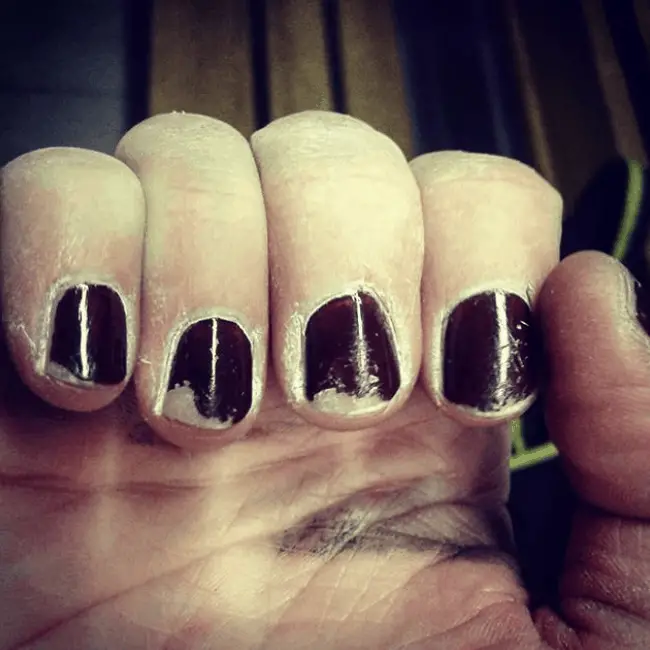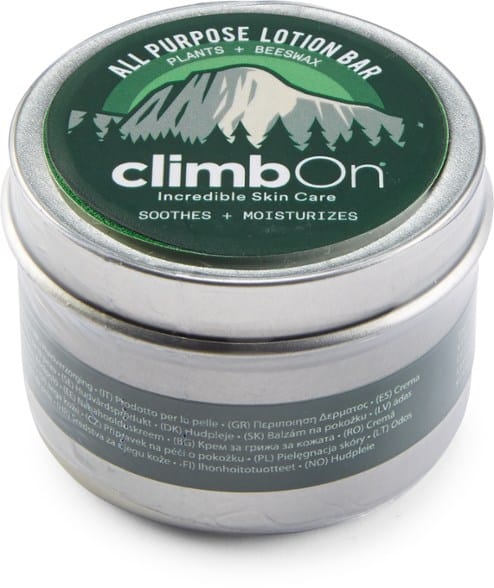
Rock climbing is one of the most exciting and rewarding sports. In addition to giving you the thrill of being up there, it helps to build up your strength and balance. However, if you’ve been climbing for a while, you may have realized that both fingernails and toenails are susceptible to damage – they get scuffed, chipped, or broken. This can leave first-time rock climbers who love well-manicured nails frustrated. In this article, we’re going to look at how to care for your nails after rock climbing and strengthen them for this fantastic sport.
So, how can you care for damaged nails from rock climbing? If you’ve just come from a rock climb and your nails look chipped or broken, the first step should be trimming them. Trimming removes longer, damaged parts of your nails since they can’t be repaired. After doing this, file your nails to keep them smooth and flat.
The next step is washing your hands and feet, drying them, and applying a moisturizer. A moisturizer with essential oils is an excellent option to keep your nails hydrated and help them heal faster. Observing nail care immediately after rock climbing will keep these parts of your body looking smart and prevent further costlier damages.
Note: If you have extremely long fingernails, it’s always advisable to trim them before going on a rock climbing adventure. The longer your nails, the more they’re susceptible to damage. And not only that, incredibly long fingernails can make this activity a painful experience because of various dynamic moves you’ll have to make. Sometimes you need to jump to reach a certain spot. Therefore, trim them, but don’t overdo it.
Page Jumps
- Why Do Your Finger and Toe Nails Get Damaged from Rock Climbing?
- Cuticle and Nail Moisturizing Tips
- How to Strengthen Your Nails
- Avoid Harsh Chemicals and Products That can Damage your Nails
- Change Your Daily Activities
- Men and Women’s Hands & Nails Are Different
- General Hand Skincare After Rock Climbing
Why Do Your Finger and Toe Nails Get Damaged from Rock Climbing?
There are several causes responsible for finger nail damage and toe nail damage, one of them is chalk. While rock climbing or bouldering, chalk is an essential element to keep hands dry and increase friction. Since climbing is an intense activity, the skin may produce oils and sweat. This extra moisture can make the process slippery and hard.
Chalk comes in handy to dry the excess moisture, increase friction, and boost a person’s grip. However, using chalk comes with one downside – skin over-drying. Especially if you’re using a product with lots of drying agents, you may end up with an over-dried skin and cracked nails.
The second cause for damage is dirt. As you hold to get a better grip, dirt may get trapped inside your nails. If the dirt is too much, it can cause expansion, which may lead to cracking.
The third cause for nail damage is gripping hard. As we mentioned earlier, rock climbing is an intensive sport that involves various dynamic moves. As you jump from one spot to another, gripping hard can make your nails crack or chip. This can happen especially if yours are weak or bristle.
Cuticle and Nail Moisturizing Tips
Since one cause for damaged nails from climbing is excessive chalk usage, WebMD recommends moisturizing to make them healthy again. After trimming to remove the damaged parts of your nails, wash your hands and feet thoroughly after rock climbing. Check under your nails to see if there is any dirt present and remove it using tweezers.
One thing to note is that you shouldn’t wait to wash your hands and feet later, you should do it immediately after the rock climb activity. Why? The longer dirt is trapped inside, the more the damage. No matter how tired you are, clean right after the session to get rid of dirt and excess chalk.
After washing, the next step is applying a moisturizer. You can go the less costly route and choose a petroleum jelly like Vaseline. Or you can choose other moisturizers as well, for instance, those rich in nutrients such as almonds, avocado, olive, and vitamin E to keep your nails and cuticles hydrated.
If your moisturizing product contains urea, phospholipids, or lactic acid it’s also an excellent choice to prevent your nails and cuticles from further cracking.
Now, I’ve tried a few different climbing balms as I have seriously dry skin on my hands. The best I’ve found is actually one of the more affordable ones from climbOn. It’s more than half the price of the one from Climbskin and I think it does just as good of a job.
Now, while it’s good to moisturize after rock climbing, it’s also wise to take measures before this activity to prevent a lot of damage. One thing you can do is choose the right chalk. Some chalks have lots of drying agents or impurities which lead to over-drying and cracking. Stay away from these. Choose chalk with very little or none of these elements. This way, you can increase friction and at the same time keep your cuticles and nails healthy.
I’ve taken so much time finding the right chalk that works for my dry hands, but also makes my climbing experience enjoyable. If you’d like to check out the reviews of my 2 favorite chalks then just go to my recommended climbing chalk page.
How to Strengthen Your Nails
Weak nails are prone to breaking while gripping. Luckily, there are several things you can do to strengthen them. They include:
- Drink enough water every day. When nails are less-hydrated, they become brittle and are more prone to breaking. At least 8 glasses of water every day are enough to keep your nails and cuticles strong and hydrated.
- Be wary of the nail products you use. Some have harsh chemicals that can damage and weaken nails.
- Eat foods rich in proteins and calcium. These are nutrients vital for strong nail growth.
- Moisturize your nails and hands regularly. Particularly if you’re a fan of hand sanitizers and wet wipes, most of them contain alcohol which can cause dehydration. Moisturize your hands after using them.
- Take breaks for nail polish. Nail polish makes your nails look attractive, but doing it all the time can weaken your nails. Take breaks and allow them to breathe. Also, take a longer time with your polish on. Constant use of nail polish removers can cause dehydration and weaken your nails.
- Limit the time your hands are exposed to water. If you’ll be cleaning for a long time, use gloves.
- Massage the end of your fingers daily to increase blood flow to this area.
- Consider taking biotin supplements. Biotin is also known as vitamin B7, and it’s a proven nutrient that aids in the strengthening of nails.
You should also trim your nails regularly. Shorter nails are stronger and less vulnerable to damages. And for this task, use a nail cutter and not your teeth.
Avoid Harsh Chemicals and Products That can Damage your Nails
How safe are the nail products you use? You may be having brittle weak nails, but your chosen products may be the reason. For instance, Formaldehyde is used for hardening nail polishes and protecting them from bacterial growth. However, what you may not know is that it also dries out skin and nails. Your nails will look beautiful, but as time goes by, they’ll weaken. Other chemicals to stay away from are toluene, dibutyl phthalate (DBP), acetone, acetonitrile, butyl acetate, and many others.
In addition to dehydrating your nails, these chemicals also have other negative health effects in our bodies. Therefore, it’s best to stay away from them altogether. The general rule is reading about the ingredients used to make a nail product before using it.
Change Your Daily Activities
How you conduct your daily activities can make a significant effect on the strength and health of your nails. For instance, cleaning products used to wash utensils have harsh chemicals to help get rid of stains. How these chemicals are tough on stains is the same way they’ll be tough on your skin and nails. They’ll weaken them. Therefore, consider wearing plastic gloves the next time you’re cleaning dishes to avoid direct contact with these chemicals.
The other thing you can do is limiting dirt exposure to your hands and feet. While doing activities such as gardening outside, wear shoes and gloves. Excessive dirt exposure can call for thorough cleaning, which can weaken your fingernails and toenails.
The other thing you can do is to avoid exposing your hands to cold temperatures. Chilly weather can dehydrate your skin and leave it looking dry and scaly. Consider wearing gloves or mittens to keep your hands warm.
Men and Women’s Hands & Nails Are Different
Men’s and women’s nails are different in several ways. One way is that men’s nails tend to grow faster than women’s, except when a woman is pregnant. Therefore, men’s nails will need frequent trimming compared to women’s nails.
The second difference is that men’s hands and nails are tougher, thicker, and therefore stronger. That means they suffer lesser damage after rock climbing than women’s.
General Hand Skincare After Rock Climbing
If you’re an enthusiastic rock climber, your hands are the most important tools to help you grip and scale. Therefore, you should keep them in excellent condition for your next climb. That means you should observe general hand skincare after every session.
Wash your hands to remove chalk and dirt particles. While washing, check for any injuries. As you climb, your hands may scrub against other rocks and develop scratches and wounds. Handle them using an ointment or an antibacterial gel.
As you take care of scratches on your hands, don’t forget to moisturize. Chalk can dry out your hands and leave them dehydrated; moisturizing re-hydrates the skin to keep your hands and nails healthy.
It took me a couple of years to find the best ways to treat my hands that have been beaten up by climbing. Luckily for anyone else suffering out there, I’ve done a whole article where I’ve included my tips and tricks on how I treat my sore hands after rock climbing.
Climbing is an intense activity that can bring finger nail damage and toe nail damage. Observing nail care for rock climbing is the key to preventing and handling these damages. Good luck and enjoy your next adventure!

